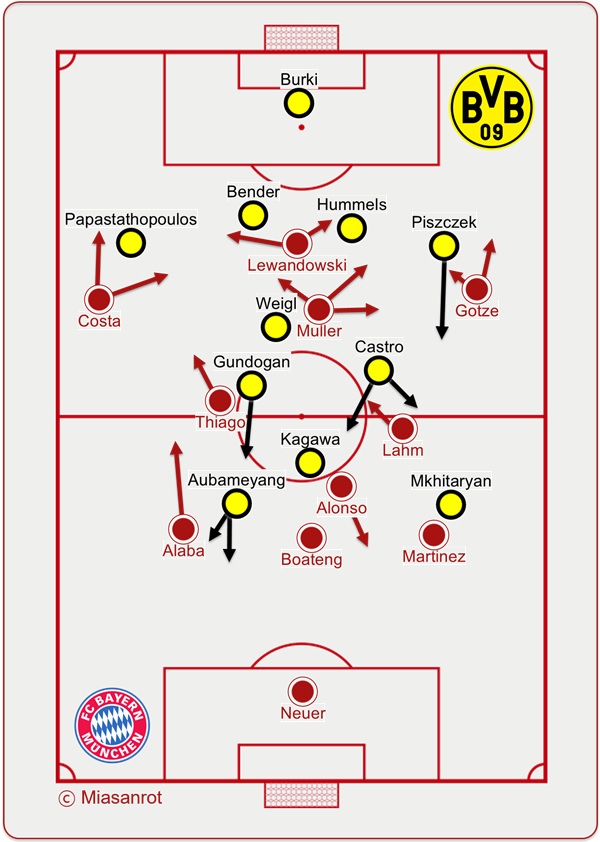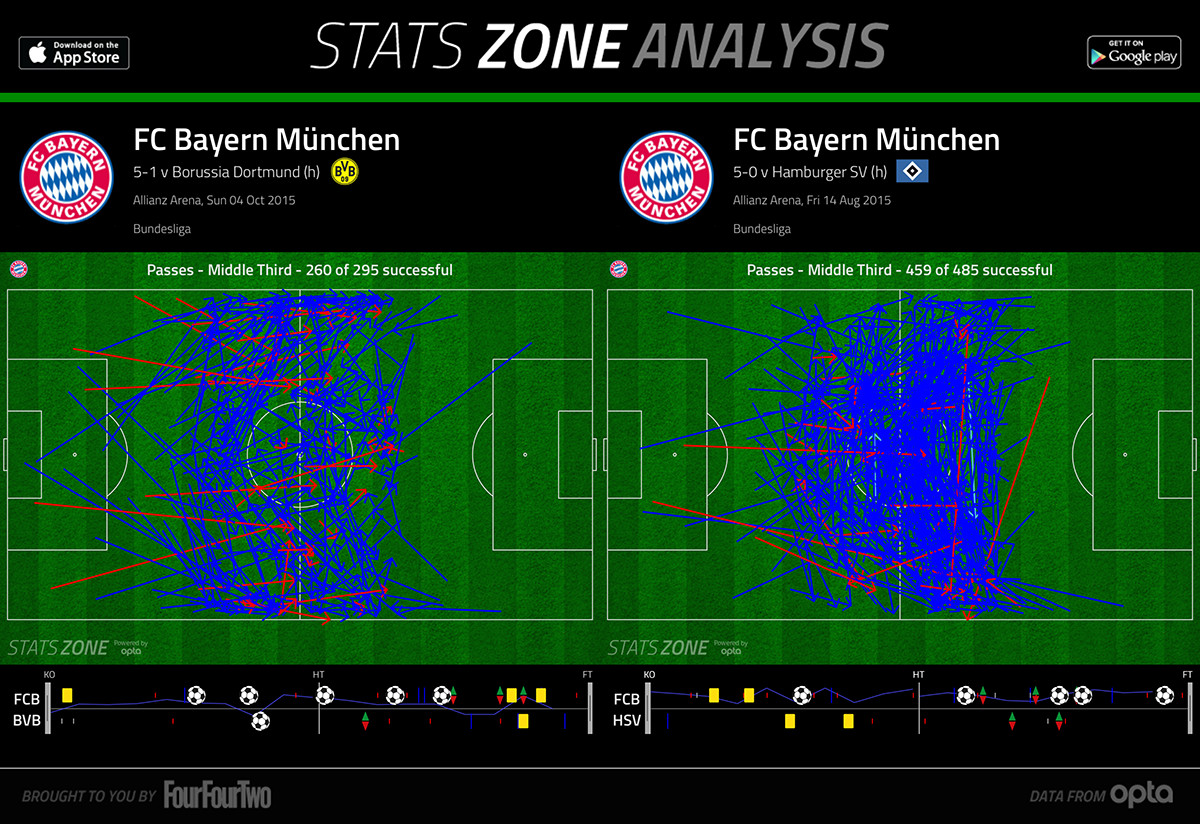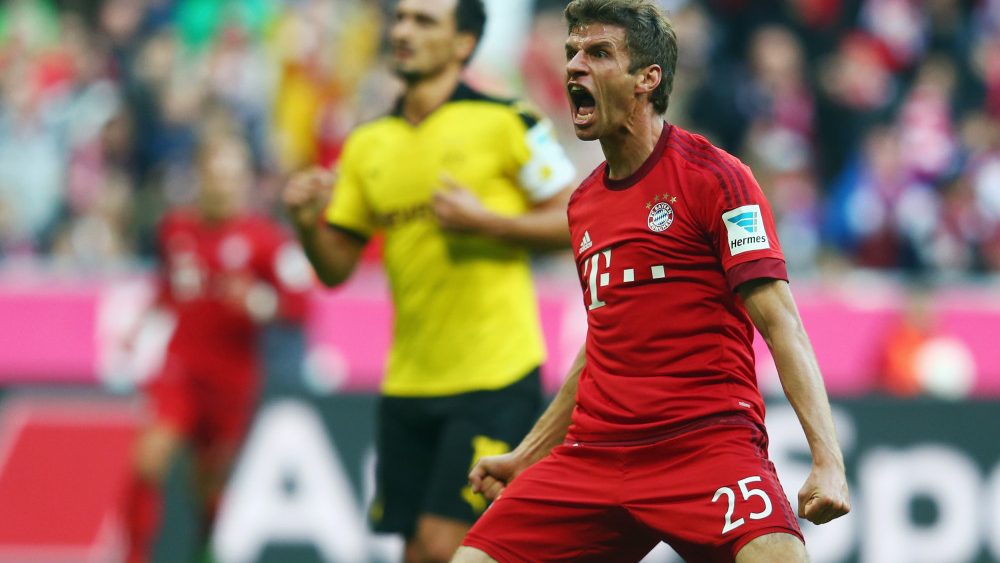Tactical Review: FC Bayern München – Borussia Dortmund 5-1 (2-1)
Much like El Clasico, Bayern v Dortmund carries its own soap-opera with it. Although nothing will likely trump the battle of “good v evil” of Guardiola v Mourinho, Sunday’s top of the table clash had plenty of storylines suitable for a prime time drama. Two former Dortmund stars in the starting line-up for Bayern; a Munich reject at the heart of Borussia’s defence; a Bavarian rising star pulling the strings for BVB; a young manager looking to upstage the man he exchanged ideas with during his sabbatical – it has it all.
This latest episode in the Bayern Munich saga proved to be no different. A cerebral joust of the highest quality ensued between two of the brightest stars in management at the Allianz Arena, with each tactical attack being met with a riposte and subsequent counter-riposte, while the result was as dramatic as the underlying narrative itself.
Tactical Flexibility

Bayern surprised many when they lined up for the first half. Having picked Lahm, Martinez, Boateng and Alaba, it was expected that they would play as a back four, with Thiago and Alonso together in midfield with Muller at 10. In fact, they started as a back three – Martinez in between Boateng and Alaba – with Lahm and Thiago flanking Alonso in the halfspaces.
The inclusion of both Lahm and Thiago in the midfield line, although surprising given the selection, was not without its logic. Both players are impressively press-resistant, in that their positioning, body orientation, ability to move the ball out of a pressure zone to a teammate quickly and their decision making in general when being pressed is excellent.
In this sense, the midfield selection followed a similar logic as the Leverkusen match, albeit with a different solution. Having two players in the midfield capable of playing out of pressure allows the considerably more vulnerable Xabi Alonso more freedom to play his own game. This coupled with the fact that Dortmund are not as hyper-aggressive in their pressing as Leverkusen were, let Alonso play in his usual position rather than the midfield/centre-back hybrid role he adopted against Bayer.
The central defensive role was subject to the first tactical change of the match. Javi Martinez struggled to provide quality vertical passes in the opening minutes, leading Guardiola to switch him to the right of the three with Boateng moving into the middle. This proved to be a key change, as Boateng’s incredible passing range was now in full display – with the German consistently pinging booming diagonals to both flanks with either foot in addition to assisting two goals with fantastic long passes, dropping between the defensive line and goalkeeper.
Further up the pitch the selection was more standard. Costa took up his regular position on the left hand side, with a view to attack Papastathopoulos at right back at every opportunity; Muller played as only Muller can – drifting to either side to open up the centre for his teammates to operate in, and bursting into space just as it’s created behind the defensive line – in true Raumdeuter fashion.
Dortmund’s selection was similarly raised a few eyebrows. With neither Schmelzer nor Joo-Ho Park fully fit, it was Lukasz Piszczek who filled the left-back berth with the aforementioned Papastathopoulos moving to right-back, and Bender filling in in defence alongside Hummels. In midfield, Castro and Gundogan played either side of Julian Weigl – the unflappable 20-year-old central midfielder with incisive passing that could split even an atom. Up front, Kagawa played behind Aubameyang and Mkhitaryan, the three of them attempting to put pressure on Bayern’s back line to stop them progressing into the midfield successfully.
Despite this, Alaba had a period of dominance just after Bayern’s first goal. Carrying the ball a number of times into midfield, unopposed by Aubameyang or Gundogan, he was free to disrupt the Dortmund defensive structure by drawing players towards the ball before passing to the players subsequently freed up. One such foray in the 30th minute prompted Tuchel to change to a 4-2-3-1 with Castro on the right to keep Alaba in check.
A consequence of this change was that Dortmund now had more width in attack whilst retaining the use of Kagawa at 10. Indeed their goal came from a pass from the ten space to Castro wide on the right, followed by a low cross to Aubameyang who had seared through Martinez’s blind-spot to arrive unopposed at the back post to slide the ball home. When the diagonal pass to Castro was played, Dortmund had a 4v3 advantage over the Bayern defence.
The near instant success of Dortmund’s change in shape and the overload it created behind the Bayern midfield led to Guardiola making a change in shape of his own. Also moving to a 4-2-3-1 – which sometimes turned into a 4-1-4-1 when Thiago pushed up – Lahm dropped into his classical position at right back. This let Bayern better control the wide areas, now populated by Mkhitaryan on the left and Castro, as mentioned already, on the right, as well as monitoring Aubameyang’s lateral runs.
Herr Guardiola’s “Plan B”
While the flexibility of the players on both teams to play the systems they were asked to throughout the game is commendable, it is the flexibility of Guardiola’s approach that really impressed and arguably is more significant. Speaking at the start of the season, the Bayern manager insisted that he was not trying to change the identity of the club and that was there to “learn the German mentality.” No clearer has his gradual transition been than against Dortmund.

Bayern’s long passes against Dortmund and Wolfsburg

Bayern’s passes in midfield against Dortmund and Hamburg
Bayern needed to alter their approach to mitigate Dortmund’s strengths. Despite greatly improving his side’s attacking positional structure to the point of making them arguably Europe’s best team at the start of the season, Thomas Tuchel has been wise not to discount the foundations that his predecessor, Klopp, laid. Dortmund are still one of the finest counter-attacking teams in world football, with their pace and verticality on the break near impossible to stop. Guardiola was clearly wary of this fact, and Bayern as a result bypassed the centre of the pitch in the build-up – an area from which counter attacks are most likely to be successfully launched.
Bayern instead focused on a strong wing-oriented approach. While this is a trend Guardiola has been setting for a while now in Munich, Sunday’s implementation of it was different. Whereas Guardiola usually asks his team to build on one wing to draw the opposition across before transferring the ball rapidly to the underloaded far side in order to isolate a defender 1v1 or 2v1, most of Bayern’s incursions down the flanks ended on the same side as they started. This was due to the area from which Bayern would usually transfer the ball being covered and accessible more often than not for Dortmund’s midfielders to press. An intercepted pass in this area would have been disastrous for Bayern, as since the passes required to switch the play are long and lateral, the horizontal distance between the passing player and the recipient must be large. A player intercepting this type of pass has, in doing so, broken the line and can attack the defence at pace directly, with the recovering players out of position. Bayern minimised the threat of this or any related scenario occurring by avoiding horizontal passes across the centre of the pitch.
This did, however, lead to a considerable hamstringing of Bayern’s attack. With such a wing-focus, a lot of attacks resulted in Douglas Costa and Mario Gotze receiving the ball on the touchline. Although Costa is spectacular in 1v1 situations, he struggled to create any chances from the left hand side, with his crossing being particularly poor. Gotze on the right hand side – assist of the season aside – also struggled to create much, often finding himself crowded out on the flank.
With Bayern’s wing-play not providing much joy, Guardiola’s team found success in an unlikely place – long passes. The logic for Munich’s increased amount of long passes – 7.5% of all their attempted passes, compared to 6.4% in their last Bundesliga game v Mainz and 3.6% v Wolfsburg – is similar to that described earlier: by playing lofted diagonal passes over the central area not only minimises the chance of having the ball intercepted there, but long passes with a vertical component implicitly lead to horizontally compact attacking structures in most cases – making it more difficult to break through the lines from any counter attack. A large part of this system’s success is that Munich happen to have the best ball playing defender in the world in Jerome Boateng as well as the prince of verticality, David Alaba. Boateng’s ability to play these diagonal passes with either foot is invaluable as it gives him access to the full complement of passing angles.
Another important factor in the success of Bayern’s plan B was the axis upon which they played their Juego de Posicion. As mentioned before, a large part of Bayern’s game strategy at the start of the season was to gather a number of the opposition to one flank before racing the ball to the weak side in order to isolate a defender. Whereas this “bait and switch” occurs on a horizontal axis, both of Boateng’s assists came from the same tactic but translated in a vertical axis. Instead of starting their attack on the left to finish on the right, they would build their attack deep, draw Dortmund towards the ball before launching a pass into the space between the defence and goalkeeper. Through a combination of well-timed runs from Muller and Lewandowski, poor positioning and body-shape from Hummels and the high line Dortmund were drawn into playing – not to mention Burki being to sweeper-keepers what Lewis Vatton is to handbags – Bayern were able to score goals at crucial points which dramatically altered the course of the game.
While all these facets of Munich’s play contributed to a handsome win over their title challenger, they also served to show just how much Guardiola has progressed as a manager in Germany. For him to be willing to deviate so far from his comfort zone for the sake of cultural assimilation shows an admirable level of humility. Sunday’s game showed that Guardiola is certainly becoming more German, whether it be through want or necessity, but more importantly for Bayern fans, he is doing so whilst retaining the same remarkable level of success.
| FC BAYERN – BORUSSIA DORTMUND 5-1 (2-1) | |
|---|---|
| FC Bayern | Neuer – Boateng, Martínez, Alaba – Lahm, Alonso (76. Kimmich), Thiago (68. Vidal) – Götze, Müller (80. Coman), Costa – Lewandowski |
| Subs | Ulreich, Rafinha, Steinhart, Gaudino |
| Borussia Dortmund | Bürki – Sokratis, Bender, Hummels, Piszczek – Weigl, Gündogan – Castro (53. Reus), Kagawa (53. Januzaj), Mkhitaryan – Aubameyang |
| Subs | 1:0 Müller (26.), 2:0 Müller (35./Foulelfmeter), 2:1 Aubameyang (37.), 3:1 Lewandowski (46.), 4:1 Lewandowski (58.), 5:1 Götze (66.) |
| Cards | Yellow: Alaba, Boateng, Kimmich / Aubameyang |
| Attendance | 75.000 (sold out) |
| Referee | Marco Fritz (Korb) |





